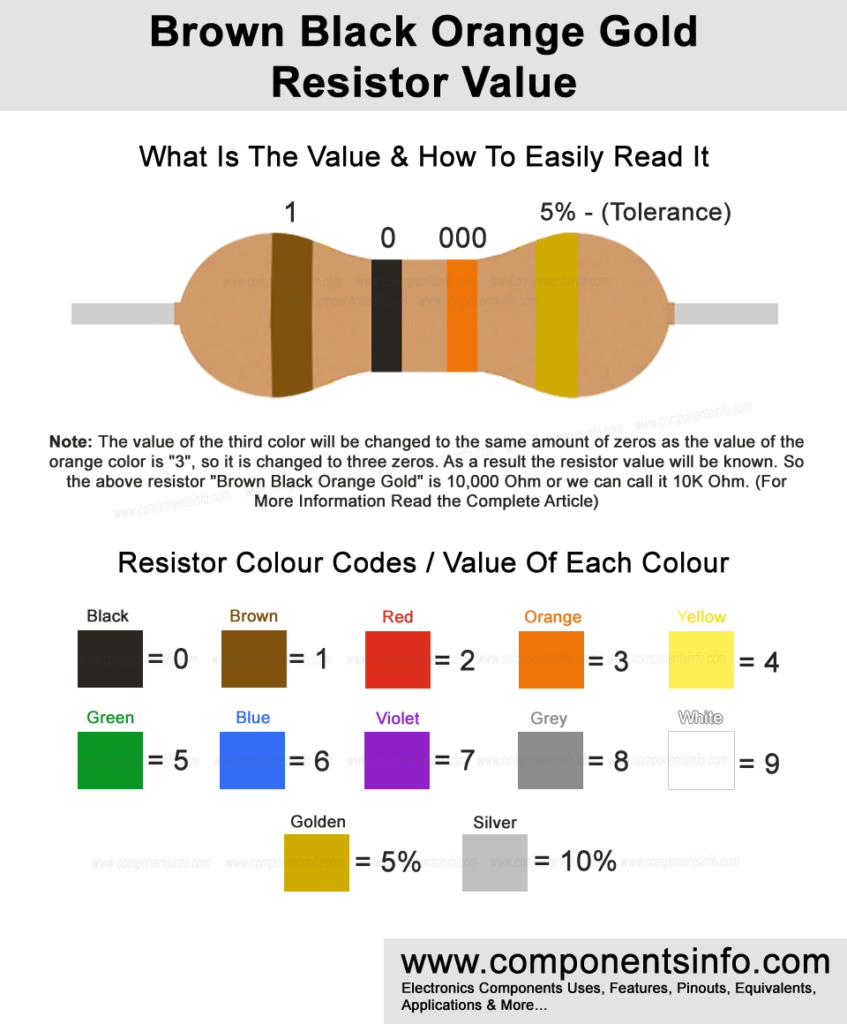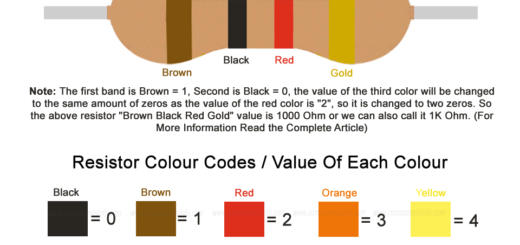Understanding Brown Black Orange Gold Resistor Value
Are you looking for the brown black orange gold resistor value then you have come to the right place. This article shows you what is the value of this resistor and also provides you with information on how to easily read the resistor values and what are the alternative ways to know the value of a fixed resistor or a variable resistor and also guide you the alternative ways to make a quick resistor of your desired value if it is not available in your lab.
Resistors are the widely used passive components of electronics made by using different materials such as metal oxide, carbon etc. They are manufactured in several different values for example from ohms to mega ohms. Resistors are available in fixed values as well as in variable values or forms which are called variable resistors for example a 1K resistor is available in fixed value and also we can find a 1K variable resistor in the market in which we can adjust or set the resistance from 1 Ohm to 1000 Ohms. So if you are an electronics engineer, student, tinkerer or hobbyist it is better to have some different value variable resistors in your lab with the fixed value resistors so in case you are working with your electronic project and can’t find a required fixed value resistor then you can easily make that value with a variable resistor due to which you will be able to continue your work without interruption.
Brown Black Red Gold Resistor Value and How To Read It
When looking at the “Brown Black Orange Gold Resistor” we see four colour bands on it. To find out the values of these colours we will look at a resistor colour code chart. The resistor colour code chart contains the values or codes of each colour that is printed on the resistor’s body. These colour codes or values are developed by the (RMS) or Radio Manufacturers Association in the 1920s till then all the resistor manufacturers follow these standard colour code values to define the value of the resistors they manufacture.
Now there are two procedures by which we can find out the value of a resistor. First I will guide the easy one which we have also mentioned in the image below. In this procedure, you have to find out the colour value/code of the first and second colour bands. Now the first colour of the transistor is brown, now look at the image above and check the code of the brown colour which is “1”. Now we will check the code or value of the second colour which is black and its value is “0”. After finding these two colour band values we will check the value of the third colour which is orange, now simply change the third colour value which is “3” to the same amount of zeros. After combining these three values we will get the value of this resistor.
The other procedure is a little bit different. In this procedure, we will check the value of the first and second colour bands the same way as we have checked in the above procedure but for the third band, we will multiply it with the values of the first two bands. Such as the brown colour value is “1” and the black colour value is “0” after combining it becomes “10”. Now for the third band, we will follow a bit similar procedure as above but only add “1” before the zeros and multiply the combined value of the first two bands with it.
10 x 1000 = 10,000 Ohms or 10K Ohms
Now, what about the fourth band which is golden or sometimes it is also silver? The fourth band is not used to calculate the value of the resistor therefore it should be ignored when you are reading any resistor value. The fourth band shows the tolerance of the resistor and the golden colour means 5% tolerance which means the resistor value will not be 100% accurate that you have read through colour bands and its value may vary 5%. Same as with the silver, if the fourth colour band is silver it means the resistor has 10% tolerance or the actual value can be 10% vary.
Some resistors also contain 5th colour band on their body, again the fifth colour band is not used to calculate the resistor value. It shows the temperature stability of a resistor and how much the value of a resistor changes when temperature changes. The 5 band resistors have more temperature stability than the four colour ones. The five band resistor is not required in normal use and the four colour band resistors are enough for a wide variety of applications. The five colour band resistors are only used in applications which require high accuracy such as in aerospace applications, medical devices, measurement instruments, scientific instruments etc.
By using the above procedures you can easily read the value of any resistor.
Alternative Ways to Check a Resistor Value
There are also other ways to check the value of a resistor in your hand. First, if you have a digital multimeter and if it has a resistor measurement mode then you can check the resistor easily by selecting that mode and connecting the two leads of the multimeter with each end of the resistor.
The other way to check a resistor is to use an LCR meter. An LCR meter is capable to read several passive components such as resistors, inductors, capacitors etc.
Additionally, you can make a DIY resistance meter easily using Arduino or other electronic platforms such as raspberry Pi. For building so a basic project building knowledge of Arduino or Raspberry Pi will be required.
Alternative Way to Make a Quick Resistor Value If You Dont Have One
Sometimes when we are working on a project and can’t find a resistor of a required specific value in your lab then there is also another way to make a desired resistor value quickly with the help of a variable resistor or a potentiometer. So if you are an electronic engineer, student, hobbyist or tinkerer this saves a lot of time, hassle and delays in your projects. Therefore it is suggested to always have some common values of variable resistors in your lab or on your table such as 1K, 10K, 100K, 1M etc.

